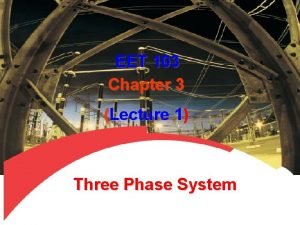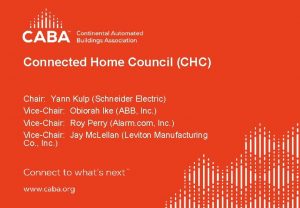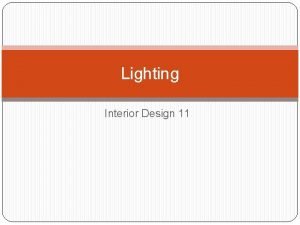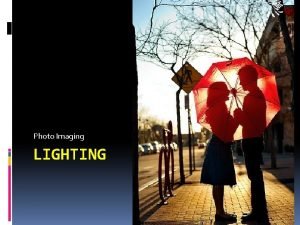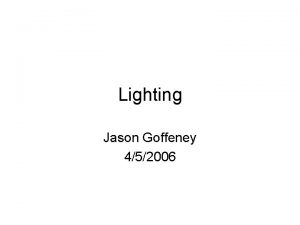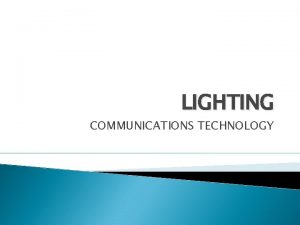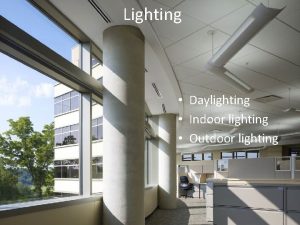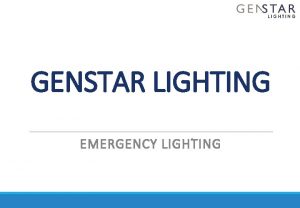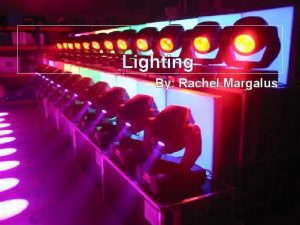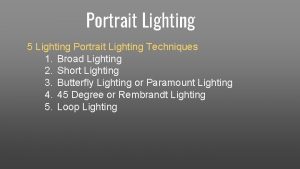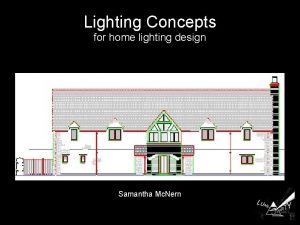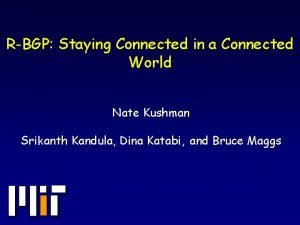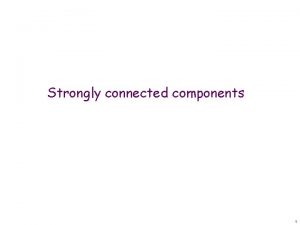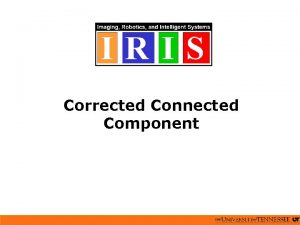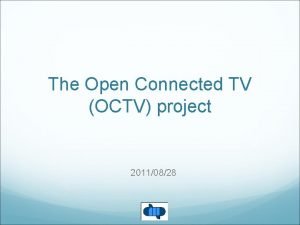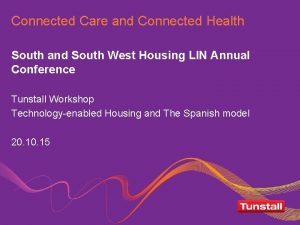LIGHTING FOR LIVING Connected Home Conference 2011 LIGHTING



































- Slides: 35

LIGHTING FOR LIVING Connected Home Conference 2011

LIGHTING FOR LIVING TODAY • What are the new requirements and why ? • What do they really mean for the home owner? • Optimal versus minimal outcomes? • Is the day of the Down Light gone?

LIGHTING FOR LIVING WHY ARE WE DOING THIS? • The Building Code of Australia. • Now the National Construction Code or NCC • Introduced Regulations detailing energy efficiency requirements • Commercial Buildings 2006 • Residential was introduced in Victoria from 1 May 2011 • Comprehensive Strategy aimed at • All Buildings throughout Australia • To address factors affecting global warming

LIGHTING FOR LIVING WHY REGULATE? • Why Regulate? • Growing Building Energy Sector • New residential market $2. 4 Billion P. A • Renovation market $2. 5 Billion P. A • Adding houses with poor energy efficiency means GHGE continue to increase & impact is extended to the next generation.

LIGHTING FOR LIVING ENERGY EFFICIENCY • The BCA (NCC) is designed to promote the prudent use of energy by • Regulatory measures • Voluntary choices • It uses building design to achieve this • Incorporates a lot more than electrical

LIGHTING FOR LIVING ADMINISTRATION of the BCA • Federally Enacted • but administered through the • individual State and Territory Building Acts • Building Regulations • For example in Victoria it is the Building Commission • BCA also calls up relevant Australian Standards

LIGHTING FOR LIVING What is covered under the new requirements • Building Classification, • Classed from 1 to 10. Class is determined by purpose for which it is designed • Classifications 3 -9 (commercial) have had energy requirements since 2006 • Class 1 a • A single dwelling • Either detached house; or • One of a group of two or more separated by a fire-wall • Class 1 b • A boarding house, guest house, hostel or the like • Total floor area not exceeding 300 m 2 • Not more than 12 persons ordinarily resident • Class 2 Multi Residential • Class 10 • Non-inhabitable building or structure • Being a garage, carport, or shed

LIGHTING FOR LIVING ADMINISTRATIVE ARRANGEMENTS currently • BCA technical requirements have to be satisfied in order to gain approval of a building proposal • Plan submission and approval procedures. • Issue of building permits. • Inspections during and after construction. • Provision of evidentiary certificates. • Issue of certificates of occupancy or compliance. • Accreditation or approval of materials or components. • Review and enforcement of standards. • Fees and charges. • How do we handle this for residential lighting?

LIGHTING FOR LIVING COMPLIANCE VARIFICATION - HOW & WHEN? • This is possibly the most unclear area as to what is needed to be provided. • Lighting design? What does that entail? • When should this be considered? • Before plans submitted • The customer will need input.

LIGHTING FOR LIVING DESIGN INPUT / TECHNICAL KNOWLEDGE

LIGHTING FOR LIVING • What are the requirements of the NCC? • Only affects NEW home construction……. . at this stage

LIGHTING FOR LIVING PART J 6 – ARTIFICIAL LIGHT & POWER • Lamp Power Density or Illumination Power Density • Excluding heaters that emit light • Must NOT Exceed 1. In a Class 1 & Class 2 residential building, 5 W/m 2 2. On a verandah or balcony, 4 W/m 2 3. In a class 10 (garage) , 3 W/m 2 NOTE: where Illumination Power Density is used it may be increased by dividing it by the adjustment factor (refer Table 3. 12. 5. 3)

LIGHTING FOR LIVING CALCULATION METHODS • Two methods • Illumination Power Density, or • Lamp Power Density • Why? It accounts for control systems

LIGHTING FOR LIVING PART J 6 – ARTIFICIAL LIGHT & POWER • Lamp Power Density - The simplest method of calculation • Total power consumed by lamps, excluding ballasts, etc • Total = nominal wattage of all lamps in the space / floor area of space • Lamps powered from GPO’s are not included • GPO’s controlled by wall switches MUST COMPLY

LIGHTING FOR LIVING PART J 6 – ARTIFICIAL LIGHT & POWER • Lamp Power Density

LIGHTING FOR LIVING PART J 6 – ARTIFICIAL LIGHT & POWER • Lamp Power Density • Ground Floor (5 w/m 2) • 208. 88 x 5 = 1044. 4 watts • Garage (3 w/m 2) • 37. 48 x 3 = 112. 4 watts • Porch / Alfresco (4 w/m 2) • 4. 11 + 10. 32 x 4 = 57. 7 watts • Total allowance for house • 1214. 5 watts

LIGHTING FOR LIVING PART J 6 – ARTIFICIAL LIGHT & POWER • Illumination Power Density • Calculates the Total power consumed by lamps, ballasts, current regulators & control devices + + • Total = power used / floor area of space • Lamps powered from GPO’s are not included • GPO’s controlled by wall switches MUST COMPLY

LIGHTING FOR LIVING PART J 6. 2(a) – ADJUSTMENT FACTORS • Illumination Power Density Adjustment Factors • Subclause J 6. 2(a)(ii) provides an alternative approach for dwellings with sophisticated control systems • These controls are likely to reduce energy used • A concession is given on the lighting power limit • Recognises situations where sensors, switching devices, control systems have an impact on performance of lighting • Clause J 6. 2(a)(iii) requires Illumination Power Density to be used

LIGHTING FOR LIVING PART J 6. 2(a) – ADJUSTMENT FACTORS • Illumination Power Density Adjustment Factor Notes • Manual Dimming • Programmed dimming • Dynamic Dimming • Fixed Dimming • Adjustment factors do not apply to incandescent or halogen lamps • Either LPD or IPD must be used not nominal allowance for batten holder • Where transformers are used - must be electronic type • Halogen lamps must be separately switched from fluorescent • Exterior lighting must be 1. 2. controlled by daylight sensor, or Lamp efficacy of not less than 40 lumens / watt

LIGHTING FOR LIVING PART J 6. 2(a) – ADJUSTMENT FACTORS

The difference between Residential and Commercial

The Difference between Residential and Commercial continued

LIGHTING FOR LIVING Lighting Design considerations • Outcome / Objective-what are you trying to achieve? Lifestyle and / or cost • Technology. What options do we have? • Cost. Installation and running • How is the light to be used? Decorative /practical / mood

LIGHTING FOR LIVING TECHNICAL PROVISION OVERVIEW • The BCA stipulates maximum power density specified as a maximum limitation of watts per square metre • The BCA does NOT specify the type or configuration of lighting installed • The BCA does NOT specify the required lighting levels in a dwelling • These decisions are design driven applications • The stipulation under BCA requirements is 5 W/m 2 for interiors, 4 W/m 2 for verandahs and balcony & 3 W/m 2 for garages, etc.

LIGHTING FOR LIVING Examples SIMULATION 100 W GLS

LIGHTING FOR LIVING SIMULATION 100 W GLS Light coverage

LIGHTING FOR LIVING Compliant SIMULATION 100 W GLS Room 5 m x 4 m 1 x 100 w GLS Ave 38 lux 5 W/m 2

LIGHTING FOR LIVING Compliant SIMULATION 100 W GLS + TASK

LIGHTING FOR LIVING Compliant SIMULATION 100 W GLS + TASK

LIGHTING FOR LIVING Compliant SIMULATION 100 W GLS + TASK Room 5 m x 4 m 1 x 100 w GLS + Task Lamp Ave 60 lux + 360 lux 5 W/m 2

LIGHTING FOR LIVING Non-Compliant SIMULATION MR 16 50 W 38 DEG

LIGHTING FOR LIVING Non-Compliant SIMULATION MR 16 50 W 38 DEG

LIGHTING FOR LIVING Non-Compliant SIMULATION MR 16 50 W 38 DEG Room 5 m x 4 m 6 x 50 w Dichroic 300 W Ave 230 lux 15 W/m 2

LIGHTING FOR LIVING TODAY So what are the answers? • What do the new requirements really mean for the new home owner? • Optimal versus minimal outcomes? Do they live in the dark? • Is the day of the Down Light gone?

LIGHTING FOR LIVING LED TECHNOLOGY • Lighting Council of Australia – SSL Scheme
 In a delta connected source feeding a y connected load
In a delta connected source feeding a y connected load In a triangle connected source feeding a y connected load
In a triangle connected source feeding a y connected load Phase to phase voltage
Phase to phase voltage Elisabeth brinton
Elisabeth brinton Gcyf 2011 annual conference
Gcyf 2011 annual conference Chwhite
Chwhite Is a burning candle living or nonliving
Is a burning candle living or nonliving Living non living dead
Living non living dead The smallest living unit of all living things is
The smallest living unit of all living things is Difference between living and non living organisms
Difference between living and non living organisms Patient centered medical home conference
Patient centered medical home conference Come home come home jesus is calling
Come home come home jesus is calling Plural of flower
Plural of flower She said that, home economics stands for the ideal home.
She said that, home economics stands for the ideal home. Pengertian homecare
Pengertian homecare Oak springs rv park
Oak springs rv park Home sweet home: survive
Home sweet home: survive Perbedaan home care dan home visit
Perbedaan home care dan home visit Let's go to my house let's go today
Let's go to my house let's go today Mobile home exchange
Mobile home exchange André fougeron
André fougeron Strategi för svensk viltförvaltning
Strategi för svensk viltförvaltning A gastrica
A gastrica Stig kerman
Stig kerman Informationskartläggning
Informationskartläggning Typiska novell drag
Typiska novell drag Tack för att ni har lyssnat
Tack för att ni har lyssnat Läkarutlåtande för livränta
Läkarutlåtande för livränta Klassificeringsstruktur för kommunala verksamheter
Klassificeringsstruktur för kommunala verksamheter Cks
Cks Inköpsprocessen steg för steg
Inköpsprocessen steg för steg Påbyggnader för flakfordon
Påbyggnader för flakfordon Tack för att ni lyssnade
Tack för att ni lyssnade En lathund för arbete med kontinuitetshantering
En lathund för arbete med kontinuitetshantering Egg för emanuel
Egg för emanuel Atmosfr
Atmosfr

